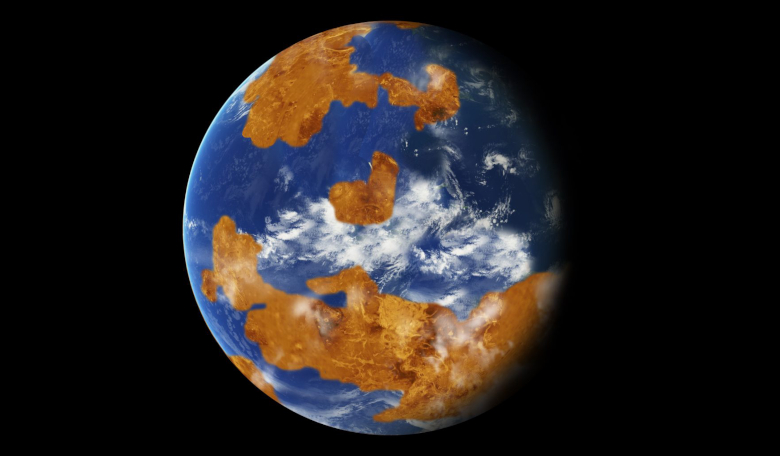Venus, Earth and Mars - three terrestrial rocky planets with widely different environments; now at least anyway. However in the beginning could all of the inner planets started off roughly the same? Earth we know has had liquid water on its surface for billions of years and although it is a dry and barren planet now, there is a lot of evidence to suggest that Mars too once supported an ocean. But what about Earth’s cloud covered twin, Venus? According to a new study presented at this years EPSC-DPS Joint Meeting, Venus may have once looked like our own planet – a temperate world hosting liquid water for as long as two to three billion years, until a dramatic transformation 700 million years ago changed it forever.
Venus is a tricky planet to study. It is enshrouded by a thick, dense atmosphere, consisting of more than 96 percent carbon dioxide intermingled with sulphuric acid that is opaque to visible light. This heavy gas means that atmospheric pressure at the planet's surface is 92 times that of Earth, so if you could plant your feet on its surface, you would experience the same crushing pressure that you find 900 metres (3,000 feett) down underwater on Earth.
Venus is also by far the hottest planet in the Solar System, with a mean surface temperature of 735 K (462 °C). But none of these adverse features has stopped scientists from trying to take a peek beneath the clouds to see what lies beneath.
The first successful Venus probe was the Mariner 2 spacecraft, which flew within 35,000 kilometres of the planet in 1962. Since then there have been a whole plethora of unmanned missions to this hostile world, including NASA’s Pioneer mission and Russia’s three Venera spacecraft.
Spring forward 40 years and a new study building on the data collected by these early missions has helped two scientists, Michael Way from the Goddard Institute for Space Science and and his colleague, Anthony Del Genio, to paint a new view of Venus’s climatic history.
To see if the now inhospitable Venus might ever have had a stable environment capable of supporting liquid water, Way and Genio created a series of five simulations assuming different levels of water coverage over the planet.
Three of the five scenarios assumed the topography of Venus as we see it today - a world mostly covered by smooth volcanic plains interjected with two highland "continents”.
In these simulations, a deep ocean averaging 310 metres, a shallow layer of water averaging 10 metres and a small amount of water locked in the soil was modelled. For comparison, Way and Genio also included a scenario with Earth’s topography and a 310-metre ocean and, finally, a world completely covered by an ocean of 158 metres depth. The scientists also accounted for changing atmospheric compositions over the eons and how solar radiation from the Sun has increased up over its lifetime.
In all five scenarios, the duo found that over a three billion period, Venus was able to maintain stable temperatures between a maximum of about 50 degrees Celsius and a minimum of about 20 degrees Celsius.
Whats more, if it wasn’t for a series of outgassing events approximately 700-750 million years ago whereby carbon dioxide stored in the planet’s rocks was released en masse, then Venus might still a temperate world today. The cause of the outgassing that led Venus’ dramatic transformation is still not fully explained, although there is a strong indication that it is linked to the planet’s volcanic activity.
“Our hypothesis is that Venus may have had a stable climate for billions of years. It is possible that the near-global resurfacing event is responsible for its transformation from an Earth-like climate to the hellish hot-house we see today,” said Way.
The debate is still on as to whether Venus is beyond the inner boundary of our Solar System’s habitable zone and therefore too close to the Sun to support liquid water, but this new research certainly favours such a situation.
“Venus currently has almost twice the solar radiation that we have at Earth. However, in all the scenarios we have modelled, we have found that Venus could still support surface temperatures amenable for liquid water,” said Way.
The study is not only relevant to Venus, but could also be useful for extrapolating whether exoplanets in similar orbits could potentially host life or not.
“We need more missions to study Venus and get a more detailed understanding of its history and evolution,” said Way. “However, our models show that there is a real possibility that Venus could have been habitable and radically different from the Venus we see today. This opens up all kinds of implications for exoplanets found in what is called the ‘Venus Zone’, which may in fact host liquid water and temperate climates.”











